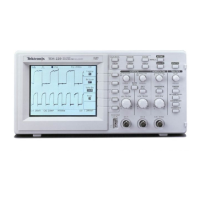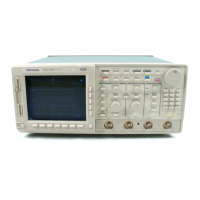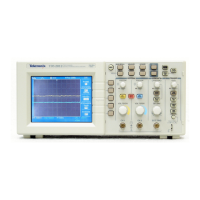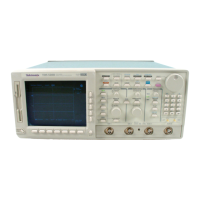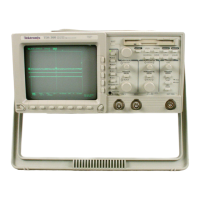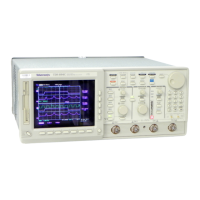Installation
2-4
TDS 420A, TDS 430A & TDS 460A Service Manual
Applying and Interrupting Power
Consider the following information when you power up or power down the
oscilloscope or when power is interrupted due to an external power failure.
Upon powering on, the oscilloscope runs its power-on self check. If the self
check passes, the oscilloscope displays a “passed” status message and a prompt
to press CLEAR MENU to continue. If the self check fails, the oscilloscope
displays a diagnostic log that identifies the area(s) that failed and a prompt to
press CLEAR MENU to continue. See Chapter 6, Maintenance, for information
on diagnostics and fault isolation.
CAUTION. DO NOT power down the oscilloscope w hen either running a signal
path compensation or when doing any of the adjustments described in Chap-
ter 5, Adjustment Procedures. To do so might result in the loss of internally
stored adjustment constants.
In general, do not power off the oscilloscope when doing operations that affect
the data types listed in Table 2--3. Wait for the oscilloscope to finish the
operation when doing adjustments, saving waveforms, or saving setups. After
operations complete, wait at least four more seconds before turning the
power off.
Improper power-down or unexpected loss of power to the oscilloscope can result
in corruption of non-volatile RAM (NVRAM). The following table describes the
messages displayed when power is restored after an abnormal power-down.
Table 2- 3: Effects of Corrupt ed Data
Corrupted Data Type Results
Adjustment Constant s:
H Signal Path Compensation
A signal path compensation is required.
H Voltage Reference
A voltage reference adjustment is required
(Chapter 5)
H Low or High Frequency Response
A frequency response adjustment is required
(Chapter 5)
H Trigger Skew
A trigger skew adjustment is required
(Chapter 5)
Error Log Errors logged are l ost
Power-On
Power-Off
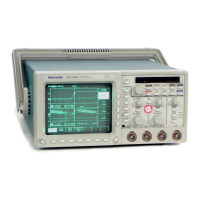
